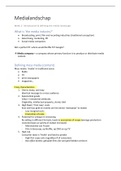Medialandschap
Week 1: Introduction & defining the media landscape
What is ‘the media industry?’
• Broadcasting, print, film and recording industries (traditional conception)
• Advertising, marketing, PR
• Social media companies
Not a perfect fit: where would Netflix fit? Google?
à Media company = a company whose primary function is to produce or distribute media
content.
Defining mass media (content)
Mass media: ‘media’ in traditional sense
• Radio
• TV
• print newspapers
• magazines…
5 key characteristics
1. One to many, one-way
Identical message to a mass audience
2. Experiential goods
Value = immaterial attributes
Originality, intellectual property, stories told
3. High fixed / ‘first copy’ costs
Kost veel tijd, geld en moeite om het eerste ‘exemplaar’ te maken
- Low marginal costs
- Economies of scale
4. Potential for (cheap) re-versioning
Re-selling in different formats, leads to economies of scope (average production
costs decrease as variety of output increases)
- Merchandise van Frozen
- Film in bioscoop, op Netflix, op DVD en op TV
5. High risk
Consumer taste is ‘frickle’ and hard to predict
- High first copy costs regardless # of consumers
- Box office bombs: gefaalde films die veel geld hebben verloren
,Defining the mass media market
• Dual-product market:
Media companies produce 2 things
- Content: sold to audiences
- Audiences: sold to advertisers
• ‘Attention economy’
- Attention is the real product being sold/bought
à Result: advertising goals influence content/strategy
• Problematic for journalism particularly (roddelbladen vs objectief (saai) nieuws)
• Broader inherent tension: creative industries vs commercial nerds
Mass media market is changing
Digitalization / digital technologies are biggest force
4 main outcomes
1. Convergence
Previously separate channels fused:
- Channels
- Content
- Computing
2. Interactivity
Two-way replaces one-way
- Users become (mass) producers
- Vb: kunnen makkelijker in contact komen met journalisten
- Vb: zelf veel makkelijker mass media producers zoals op Instagram
3. Diversification
Toegenomen
Heightened user control & choice
- Fragmentation / expansion of content
- Meer keuze in soort
- Meer controle over wat je wilt gebruiken
4. Mobility
Media ‘on the go’ becomes norm
- ‘always on’ culture
Complication
Media organizations (at least some?) should be socially responsible.
• A few core responsibilities:
- Forum for exchange of ideas/opinions
- Integrative influence for diverse societies
- Protection of core values/vulnerable audiences
Mostly for journalism, but also others?
,Hence: strong reactions to change
McLuhan’s optimism
• Technology itself matters
• New tech extends senses
• New ‘cooler’ media
- Liberate audiences from hierarchies, isolation
- Away from officialdom toward ‘everyday talk’
- Toward a global village
Postman’s pessimism
• Print age:
- Detailed
- Relevant
- Localized
- Coherent
- Rational
• Post-telegraph:
- Dazzling stories
- From afar outweigh the relevant, local
- Lokaal nieuws boeide niet meer, maar spannendere dingen van ver
Oppervlakkig
• TV/images à superficiality
• Attention and rationality gone down
• Passive audience
Critiques of the critiques
Both: technological determinism
• Technology itself = primary cause of social change
• Simplifies & overplays tech, ignores social context
• Ignores power relations behind development/use
- Optimism: tech as solution to manmade problems
- Pessimism: blames tech for social problems
à Problematic because just focus on the tech and not social context
Another approach
Du Gay’s et al. (1997)’s “circuit of culture”
Belang, waarde
Tech’s significance best understood thru 5 processes:
1. Production: how/when/why was it developed?
2. Representation: how is it talked about?
3. Regulation: how is it controlled?
4. Consumption: how do we use it?
5. Identity: what does it say about us, when we use it?
, Conclusie
• Media industry has shifting borders, definitions
• Its products, market structures are unique
• It’s undergoing massive changes
• Theorists react to those changes very strongly
- And companies do, too
• But we are constantly engaging with it
- Now… to the ‘media life’ idea from Deuze
Media life (Deuze, 2011)
Media now so central that we don’t notice them
à We don’t live with media, but in media
Verschijnselen
2 clear manifestations
1. Personal/individualized information space
2. Always-available global connectivity
2 main consequences
1. Liquefied boundaries between work/play/alone/interaction
Plaats maken voor / benutten
2. Life now changed to accommodate/exploit media
Samenhang
Diversification, interactivity, mobility, convergence are all reflected here.
Technological changes/responses create this new individualized connectivity.
Summary
• Media industry, mass media, & market:
- Unique characteristics, fuzzy borders
- Social resp./creative-commercial tension unique
• Rise of digital media = further challenges, changes
• Systematically opposed responses to change
• ‘Media life’: one approach to theorizing media
- Importance of ‘individualized information spaces’
• We saw (reinforced) individuality in your own habits
Key concepts
• 5 characteristics of mass media
• Economies of scale, economies of scope
• Dual product market
• Convergence, Interactivity, Diversification, Mobility
• Media’s core responsibilities
• McLuhan’s optimism vs Postman’s pessimism
• Technological determinism
• Circuit of culture
• Media life





